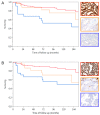Association of Hormone Receptor Expression with Survival in Ovarian Endometrioid Carcinoma: Biological Validation and Clinical Implications
- PMID: 28264438
- PMCID: PMC5372531
- DOI: 10.3390/ijms18030515
Association of Hormone Receptor Expression with Survival in Ovarian Endometrioid Carcinoma: Biological Validation and Clinical Implications
Abstract
This paper aims to validate whether hormone receptor expression is associated with longer survival among women diagnosed with ovarian endometrioid carcinoma (EC), and whether it identifies patients with stage IC/II tumors with excellent outcome that could be spared from toxic chemotherapy. Expression of estrogen receptor (ER) and progesterone receptor (PR) was assessed on 182 EC samples represented on tissue microarrays using the Alberta Ovarian Tumor Type (AOVT) cohort. Statistical analyses were performed to test for associations with ovarian cancer specific survival. ER or PR expression was present in 87.3% and 86.7% of cases, respectively, with co-expression present in 83.0%. Expression of each of the hormonal receptors was significantly higher in low-grade tumors and tumors with squamous differentiation. Expression of ER (Hazard Ratio (HR) = 0.18, 95% confidence interval 0.08-0.42, p = 0.0002) and of PR (HR = 0.22, 95% confidence interval 0.10-0.53, p = 0.0011) were significantly associated with longer ovarian cancer specific survival adjusted for age, grade, treatment center, stage, and residual disease. However, the five-year ovarian cancer specific survival among women with ER positive stage IC/II EC was 89.0% (standard error 3.3%) and for PR positive tumors 89.9% (standard error 3.2%), robustly below the 95% threshold where adjuvant therapy could be avoided. We validated the association of hormone receptor expression with ovarian cancer specific survival independent of standard predictors in an independent sample set of EC. The high ER/PR co-expression frequency and the survival difference support further testing of the efficacy of hormonal therapy in hormone receptor-positive ovarian EC. The clinical utility to identify a group of women diagnosed with EC at stage IC/II that could be spared from adjuvant therapy is limited.
Keywords: endometrioid; estrogen receptor; hormonal therapy; ovarian cancer; progesterone receptor; prognosis.
Conflict of interest statement
The authors declare no conflict of interest.
Figures


Similar articles
-
Hormone-receptor expression and ovarian cancer survival: an Ovarian Tumor Tissue Analysis consortium study.Lancet Oncol. 2013 Aug;14(9):853-62. doi: 10.1016/S1470-2045(13)70253-5. Epub 2013 Jul 9. Lancet Oncol. 2013. PMID: 23845225 Free PMC article.
-
The prognostic significance of estrogen and progesterone receptors in grade I and II endometrioid endometrial adenocarcinoma: hormone receptors in risk stratification.J Gynecol Oncol. 2019 Jan;30(1):e13. doi: 10.3802/jgo.2019.30.e13. Epub 2018 Oct 29. J Gynecol Oncol. 2019. PMID: 30479097 Free PMC article.
-
Fatty acid synthase is a potential therapeutic target in estrogen receptor-/progesterone receptor-positive endometrioid endometrial cancer.Oncology. 2013;84(3):166-73. doi: 10.1159/000342967. Epub 2013 Jan 9. Oncology. 2013. PMID: 23306391
-
Prognostic value of progesterone receptor expression in ovarian cancer: a meta-analysis.Oncotarget. 2017 May 30;8(22):36845-36856. doi: 10.18632/oncotarget.15982. Oncotarget. 2017. PMID: 28415663 Free PMC article. Review.
-
Endocrine therapy in endometrial cancer: An old dog with new tricks.Gynecol Oncol. 2019 Apr;153(1):175-183. doi: 10.1016/j.ygyno.2018.12.018. Epub 2019 Jan 5. Gynecol Oncol. 2019. PMID: 30616900 Review.
Cited by
-
A Review of the Clinical Characteristics and Novel Molecular Subtypes of Endometrioid Ovarian Cancer.Front Oncol. 2021 Jun 3;11:668151. doi: 10.3389/fonc.2021.668151. eCollection 2021. Front Oncol. 2021. PMID: 34150634 Free PMC article. Review.
-
Prognostic analysis for Chinese patients with stage I ovarian endometrioid carcinoma.J Ovarian Res. 2017 Sep 18;10(1):63. doi: 10.1186/s13048-017-0361-0. J Ovarian Res. 2017. PMID: 28923080 Free PMC article.
-
Immunohistochemical Biomarkers as a Surrogate of Molecular Analysis in Ovarian Carcinomas: A Review of the Literature.Diagnostics (Basel). 2021 Jan 29;11(2):199. doi: 10.3390/diagnostics11020199. Diagnostics (Basel). 2021. PMID: 33572888 Free PMC article. Review.
-
p53 and ovarian carcinoma survival: an Ovarian Tumor Tissue Analysis consortium study.J Pathol Clin Res. 2023 May;9(3):208-222. doi: 10.1002/cjp2.311. Epub 2023 Mar 22. J Pathol Clin Res. 2023. PMID: 36948887 Free PMC article.
-
Ovarian endometrioid carcinoma and clear cell carcinoma: A 21-year retrospective study.J Ovarian Res. 2021 May 4;14(1):63. doi: 10.1186/s13048-021-00804-1. J Ovarian Res. 2021. PMID: 33941230 Free PMC article.
References
-
- Köbel M., Kalloger S.E., Lee S., Duggan M.A., Kelemen L.E., Prentice L., Kalli K.R., Fridley B.L., Visscher D.W., Keeney G.L., et al. Biomarker-based ovarian carcinoma typing: A histologic investigation in the ovarian tumor tissue analysis consortium. Cancer Epidemiol. Biomark. Prev. 2013;22:1677–1686. doi: 10.1158/1055-9965.EPI-13-0391. - DOI - PMC - PubMed
-
- McConechy M.K., Ding J., Senz J., Yang W., Melnyk N., Tone A.A., Prentice L.M., Wiegand K.C., McAlpine J.N., Shah S.P., et al. Ovarian and endometrial endometrioid carcinomas have distinct ctnnb1 and pten mutation profiles. Mod. Pathol. 2014;27:128–134. doi: 10.1038/modpathol.2013.107. - DOI - PMC - PubMed
-
- Aysal A., Karnezis A., Medhi I., Grenert J.P., Zaloudek C.J., Rabban J.T. Ovarian endometrioid adenocarcinoma: Incidence and clinical significance of the morphologic and immunohistochemical markers of mismatch repair protein defects and tumor microsatellite instability. Am. J. Surg. Pathol. 2012;36:163–172. doi: 10.1097/PAS.0b013e31823bc434. - DOI - PubMed
MeSH terms
Substances
Grants and funding
LinkOut - more resources
Full Text Sources
Other Literature Sources
Research Materials

